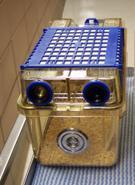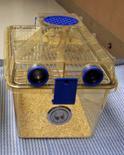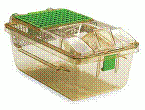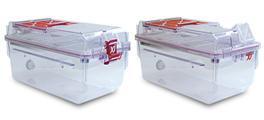Please refer to IACUC Policies, Procedures, and Guidelines Doc 110 “Housing Density”, on the Office of the Attending Veterinarian web site, in regard to housing space requirements for animals at the University of Kentucky. To ensure that Investigators and Research staff observe The Guide and subsequently the IACUC expectations for mouse housing density, DLAR's Mouse Housing Density Policy explains how DLAR will handle overcrowding in a cage.
Below are examples of the different types of mouse housing caging used in the DLAR facilities, including the number of adult animals that can be housed in each type of caging.
| Standard Static Micro Isolator Cage | This cage holds 4 adult mice, and are most often used on shelf racks. | |
| Small Tecniplast PIV Cage | This cage holds 4 adult mice. There are 144 of these cages per rack. | |
| Large Tecniplast PIV Cage | This cage holds 5 adult mice. There are 112 cages of this type on a rack. | |
| "Green Line" Tecniplast PIV Cage | This cage holds 5 adult mice. | |
| "Redline" Allentown Cage | This cage holds 5 adult mice. |
For questions concerning a certain type of cage or cages used for breeding colonies, please contact via e-mail the DLAR Animal Care Supervisor where your animals are housed, our Facilities Operations Manager, or any of the DLAR veterinarians.




